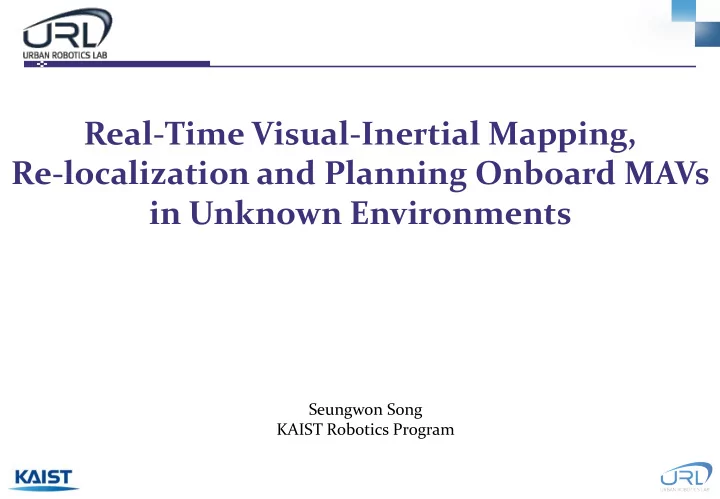

Real-Time Visual-Inertial Mapping, Re-localization and Planning Onboard MAVs in Unknown Environments Seungwon Song KAIST Robotics Program
PURPOSE OF PAPER Using Vision measurement ( Visual Odometry) IMU measurement Purpose Create consistent maps To Quadrotor relocalize itself Plan path in full 3D 1
BASIC CONCEPT Local Map building Mission Handling Relocalization Pathplanning 2
LOCAL MAP BUILDING 3
LOCAL MAP BUILDING Normal Image Keypoint Too much computation cost Make sparse pose-graph -Vertices Image keypoints Keypoint descriptor 3D triangulated landmarks (stereo cam) -Edge IMU measurements Make Submissions with independent baseframes! S. Leutenegger, S. Lynen, M. Bosse, R. Siegwart, and P. Furgale , “ Keyframe-based visual – inertial odometry using nonlinear optimization,” The International Journal of Robotics Research, 2014 4
LOCAL MAP BUILDING Submission? Reference Map Translate Translate Translate Translate Matrix Matrix Matrix Matrix Local Map Local Map Local Map Local Map 5
Mission Handling Add new local mission to Reference Map Do Bundle Adjustment (Reduce errors and drift in Odometry) Correct Translation ( 𝑈 𝐻𝑁(𝑝𝑠𝑗𝑗𝑜𝑏𝑚) → 𝑈 𝐻𝑁(𝑜𝑓𝑥) ) Using Framework that allows to access the map from several threads. ( Transaction change process + Incremental Local map) T. Cieslewski, S. Lynen, M. Dymczyk, S. Magnenat, and R. Siegwart , “Map api - scalable decentralized map building for robots,” in Proceedings of the IEEE International Conference on Robotics and Automation (ICRA), 2015 6
Relocalization I think it’s not so significant Matching BRISK keypoint descriptor Outlier rejection using RANSAC Add abstracted inliers as constraints Relocalize with past sliding windows Relocalize with low rate (estimator drift is slow relative to motion) 7
Pathplanning Based on RRT* Consider Cost! Human : Minimize the jerk ! Quadrotor : Minimize the snap! (second derivative of acceleration) (Just based on D.Mellinger & V.Kumar’s paper. See if you wonder) Trajectory refinement (with time) Trajectory refinement (with max velocity) Trajectory refinement (with state constraints) Trajectory refinement (handling collision) D. Mellinger and V. Kumar, “ Minimum Snap Trajectory Generation and Control for Quadrotors ,” in Proceedings of the IEEE International Conference on Robotics and Automation (ICRA), May 2011 8
Pathplanning Based on RRT* (Reference paper) RRT* PRUNING OPTIMIZE C. Richter, A. Bry , and N. Roy, “Polynomial Trajectory Planning for Aggressive Quadrotor Flight in Dense Indoor Environments,” in Proceedings of the International Symposium on Robotics Research (ISRR) , 2013. 9
Pathplanning Result of reference paper C. Richter, A. Bry , and N. Roy, “Polynomial Trajectory Planning for Aggressive Quadrotor Flight in Dense Indoor Environments,” in Proceedings of the International Symposium on Robotics Research (ISRR) , 2013. 10
Pathplanning Consider Cost! Sacrifice theoretical optimality but get good computation time 〮 Quadrotor : Minimize the snap! (second derivative of acceleration) 〮 Trajectory Polynomial 〮 Cost over Trajectory M segment, D dimension (So, each segment have D polynomials) The only 𝜕 4 = 1 𝑝𝑢ℎ𝑓𝑠 𝜕 = 0 Due to focus on just ‘snap’ segment 11
Pathplanning Consider Cost! 〮 Segment’s cost 〮 Segment’s coefficient To get c, we have derivative value of polynomial. We must have N coefficient (c is N × N matrix), so we only need N/2 amount of derivative for each start and end points. Selected d Calculated J Selected T Calculated C Calculated A 12
Pathplanning Consider Cost! 〮 How to get free/unspecified derivatives?(In reference paper) 𝑒 𝐺 ∶ 𝐺𝑗𝑦𝑓𝑒 𝑒𝑓𝑠𝑗𝑤𝑏𝑢𝑗𝑤𝑓𝑡 𝑒 𝑄 ∶ 𝐺𝑠𝑓𝑓 𝑒𝑓𝑠𝑗𝑤𝑏𝑢𝑗𝑤𝑓𝑡 𝐷 ∶ 𝑞𝑓𝑠𝑛𝑣𝑢𝑏𝑢𝑗𝑝𝑜 𝑛𝑏𝑢𝑠𝑗𝑦 𝑏𝑡𝑡𝑓𝑛𝑐𝑚𝑓𝑒 𝑝𝑔 0,1 Differentiating J Equating to zero C. Richter, A. Bry , and N. Roy, “Polynomial Trajectory Planning for Aggressive Quadrotor Flight in Dense Indoor Environments,” in Proceedings of the International Symposium on Robotics Research (ISRR) , 2013. 13
Pathplanning Trajectory refinement (with time) Trajectory refinement (with max velocity) 14
Pathplanning Trajectory refinement (with state constraints) Trajectory refinement (handling collision) collision New vertex 15
Result Simple 4 points (5m x 5m) 200s for initial trajectory -> 112s for optimized solution Time, success rate for amount of segment success : does not exceed the state limits by 10% 16
Result Time, success rate for amount of segment Bold : planned, dot : followed 17
Discussion In large environment, the method in this paper may take less time than sampling based method. There aren’t any compare in this paper. So we don’t know any performance of the method. Can choose the pose at each point, so It can be applied in various situation (in this paper, they set to see always in direction of flying to avoid active obstacle. 18
Recommend
More recommend